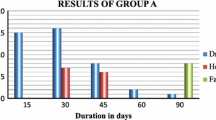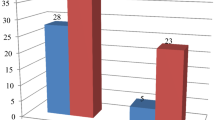Abstract
Otitis externa is an inflammatory condition of the external auditory canal which occurs due to any trauma, changes in the PH of the skin of external auditory canal. The normal PH of the external auditory canal skin should be in the acidic medium. This inhibits the growth of certain infectious microorganisms. Once the external canal skin PH becomes alkaline, the chances of inflammation of the skin increases. To assess the pH of the external auditory canal in cases of otitis externa with secretion and compare the treatment efficacy of treating it with topical anti-inflammatory like ichthammol glycerine, topical steroid cream and oral antibiotics. A prospective observational study involved a total of 120 patients who came with symptoms and signs of external otitis. pH of external canal was measured during first visit and at 42 days. The patients were divided into three groups. First group was treated with Ichthammol glycerine, second group was treated with Ichthammol glycerine with topical steroid cream and third group was treated with oral antibiotics with topical steroid cream. Patients were analyzed based on severity score during first visit, at 7 days, at 21 days and 42 days. This study involved 64(53.3%) patients were male and 56(46.7%) were females. The mean age group involved in the study was 42.50 years. The mean PH value in the external auditory canal during the first visit was alkaline (6.09) and the mean PH value at 42 days was changed to acidic (4.95) which was statistically significant (p = 0.00). There was significant reduction in the severity score in the oral antibiotic with topical steroid cream, followed by IG with topical steroid cream followed by Ichthammol glycerine (p = 0.001). In this study we have analyzed the pH level favorable in causing otitis externa and the best available treatment for the same. It has been observed that the alkaline Ph is more favorable in causing otitis externa. Efficacy of Topical corticosteroid with antibiotics is maximum in the management of otitis externa.



Similar content being viewed by others
Data Availability
The collected data will be kept confidential. All routine investigation will be done as per standard protocol.
References
Martinez-Devesa P, Willis CM, Capper JW (2003) External auditory canal pH in chronic otitis externa. Clin Otolaryngol Allied Sci 28:320–324
MAYER (1844) Beobachtungen von cysten mit fadenpilzen aus dem au sseren geho rgange eines ma dchens. Arch Anat Physiol U Wissensch Med 404–408
Anderson JR, Steele CH (1948) Use of nitrofuran therapy in external otitis. Laryngoscope 58:1279–1286
GILL E.K. (1950) Evaluation of newer drugs in the treatment of otitis externa. Arch Otolaryngol 52:25–30
Hawke M, Wong M, Krajden S (1984) Clinical and microbiological features of otitis externa. J Otolaryngol 13:289–295
Russell JD, Donnelly M, McShane DP et al (1993) What causes otitis externa? J Laryngol Otol 107:898–901
McLaurin JW, Raggio TP, McHugh-Simmons A (1965) Persistent external otitis. Laryngoscope 75:1699–1707
Marchionini A, Hausknecht W (1938) Sa uremantel der Haut und Bakterienabwehr. I. Die regiona re Verschiedenheit der Wassersstoffionenkonzentration der Hautoberfla che. Klin Wchnschr 17:663–666
Wise F, Sulzberger MB (1938) Ear book of dermato logy and syphilology. The Year Book Publishers, Chicago, p 553
Blank IH (1939) Measurement of pH of the skin surface I: technique. J Invest Dermatol 2:67–74
Berstein ET, Herrmann F (1942) The acidity on the surface of the skin. NY State J Med 42:436–442
Fabricant ND, Perlstein MA (1949) pH of the cutaneous surface of the external auditory canal: a study of twenty-seven infants, forty-four children and sixty adults. Arch Otolaryngol 49:201–209
Fabricant ND (1957) The pH factor in the treatment of otitis externa. Arch Otolaryngol 65:11–12
Van Balen FA, Smit WM, Zuithoff NP, Verheij TJ (2003) Clinical efficacy of three common treatments in acute otitis externa in primary care: randomised controlled trial. BMJ 327(7425):1201–1205
Rooijackers-Lemmens E, Van Wijngaarden JJ, Opstelten W, Broen A, Romeijnders ACM (1995) NHG-standaard otitis externa. Huisarts Wet 28(6):265–271
Kim JK, Cho JH (2009) Change of external auditory canal pH in acute otitis externa. Ann Otol Rhinol Laryngol 118(11):769–772
Mittal A, Kumar S (2014) Role of pH of external auditory canal in acute otitis externa. Indian J Otolaryngol Head Neck Surg 66(1):86–91
Funding
This study did not receive any kind of funding from any sources.
Author information
Authors and Affiliations
Corresponding author
Ethics declarations
Conflict of interest
The authors express no conflict of interest.
Ethical Approval
The study will be conducted only after obtaining approval by the Institutional Human Ethics Committee.
Consent to Participate
All patients will be treated equally irrespective of their participation in the study. The cost of any investigations required for the study will be borne by the chief investigator.
Informed Consent
Informed consent will be obtained from all the patients who participate in the study.
Additional information
Publisher's Note
Springer Nature remains neutral with regard to jurisdictional claims in published maps and institutional affiliations.
Rights and permissions
Springer Nature or its licensor (e.g. a society or other partner) holds exclusive rights to this article under a publishing agreement with the author(s) or other rightsholder(s); author self-archiving of the accepted manuscript version of this article is solely governed by the terms of such publishing agreement and applicable law.
About this article
Cite this article
Kanagamuthu, P., Dhanasekaran, B., Karthika, S.R. et al. To Determine the PH of External Auditory Canal in Otitis Externa: A Prospective Observational Study in a Tertiary Health Care Centre. Indian J Otolaryngol Head Neck Surg 75 (Suppl 1), 502–506 (2023). https://doi.org/10.1007/s12070-023-03591-x
Received:
Accepted:
Published:
Issue Date:
DOI: https://doi.org/10.1007/s12070-023-03591-x




